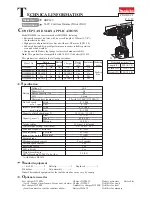
Maintenance and Storage
•
Do not touch parts which may be hot from operation.
Allow them to cool before attempting to maintain, adjust,
or service.
•
Lower the thrust frame, stop the engine, and remove
the key. Wait for all movement to stop before adjusting,
cleaning, or repairing.
•
Clean debris from attachments, drives, mufflers, and
engine to help prevent fires. Clean up oil or fuel spillage.
•
Let the engine cool before storing, and do not store near
a flame.
•
Do not store fuel near flames or drain indoors.
•
Park the machine on level ground.
•
Do not allow untrained personnel to service the machine.
•
Carefully release pressure from components with stored
energy.
•
Keep hands and feet away from moving parts. If possible,
do not make adjustments with the engine running.
•
Disconnect the battery before making any repairs.
Disconnect the negative terminal first and the positive
last. Reconnect positive first and negative last.
•
Charge batteries in an open, well ventilated area, away
from spark and flames. Unplug the charger before
connecting or disconnecting it from the battery. Wear
protective clothing and use insulated tools.
•
Battery acid is poisonous and can cause burns. Avoid
contact with skin, eyes, and clothing. Protect your face,
eyes, and clothing when working with a battery.
•
Battery gases can explode. Keep cigarettes, sparks and
flames away from the battery.
•
Keep all parts in good-working condition and all hardware
tightened. Replace all worn or damaged decals.
•
If any maintenance or repair requires the frame to be in
the raised position, secure the frame in the raised position
with the hydraulic cylinder lock; refer to
Cylinder Lock (page 82)
.
•
Keep nuts and bolts tight.
•
Keep equipment in good condition.
•
Do not tamper with safety devices.
•
Keep the machine free of grass, leaves, or other debris
build-up. Clean up oil or fuel spillage. Allow the machine
to cool before storing.
•
Use extra care when handling fuels. They are flammable
and vapors are explosive.
–
Use only an approved container.
–
Do not remove the fuel cap or add fuel when the
engine is running. Allow the engine to cool before
refueling. Do not smoke while refueling the machine.
–
Do not refuel the machine indoors.
–
Do not store the machine or fuel container inside
where there is an open flame, such as near a water
heater or furnace.
–
Do not fill a container while it is inside a vehicle,
trunk, pick-up bed, or any surface other than the
ground.
–
Keep container nozzle in contact with the tank during
filling.
•
Use only genuine Toro replacement parts to ensure that
original standards are maintained.
•
Keep your body and hands away from pin hole leaks
or nozzles that eject high pressure hydraulic fluid. Use
cardboard or paper to find hydraulic leaks; do not use
your hands. Hydraulic fluid escaping under pressure can
penetrate skin and cause injury requiring surgery within a
few hours by a qualified surgeon or gangrene may result.
Noise and Vibration Levels
WARNING
The operator must wear hearing protection when
operating the machine. Failure to wear hearing
protection may cause hearing loss.
Sound Pressure Level
This unit has a sound pressure level at the operator’s ear of 92
dBA, which includes an Uncertainty Value (K) of 1 dBA.
Sound pressure level was determined according to the
procedures outlined in EN 791.
Sound Power
This unit has a guaranteed sound power level of 110 dBA,
which includes an Uncertainty Value (K) of 3.75 dBA.
The sound power level was determined according to the
procedures outlined in ISO 4871.
Vibration Level
Measured vibration level for right hand = 1.8 m/s
2
Measured vibration level for left hand = 1.3 m/s
2
Measured vibration level for whole body = 0.03 m/s
2
Uncertainty Value (K) = 0.02 m/s
2
Measured values were determined according to the procedures
outlined in EN ISO 20643.
8









































